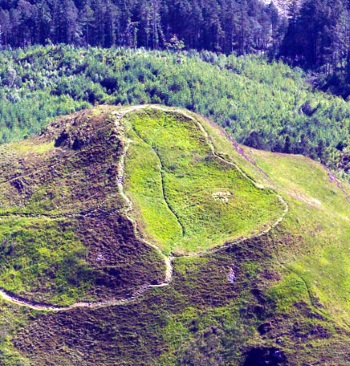
Throughout the present Celtic lands and in many of those areas once lived in by Celtic tribes, hill forts can be found. Typically they date to the Bronze and Iron Ages. Usually they followed the contours of a hill, consisting of one or more lines of earthworks, with stockades or defensive walls, and external ditches. Positioned to take advantage of the higher elevation in which they were located, they would act as a fortified refuge and defended settlement. Hill forts could be home to a significant number of people whose dwellings were built within the safety of the fortification. The hill tops on which they were built gave commanding views of the vicinity. Often they would be positioned over strategically important mountain passes or river crossings.
Many hill forts are associated with figures from Celtic legend. One such is Dùn Deardai in Scotland. Standing on a rocky knoll on Sgorr Chalum, Dùn Deardail is an Iron Age hillfort above the River Nevis in Glen Nevis. Located at a height of 1,127 ft (347m) Dùn Deardail is overlooked by the mountain of Ben Nevis (Scottish Gaelic: Beinn Nibheis) and is thought to have been constructed by the Celts in the first millennium BC (1000 BC to 1BC). The fort is associated with Deirdrê of the Sorrows, the tragic heroine in Irish pre-Christian legend, whose story is told in the ancient Irish mythology of the Ulster Cycle. Deirdrê and the three sons of Usnach were said to have lived near the fort for some of the time they stayed in Scotland.